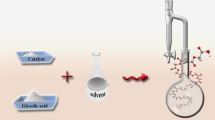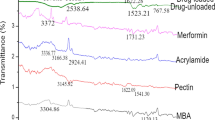Abstract
The changing morphology of quenched polyglycolide (PGA) is investigated during hydrolytic degradation in phosphate buffered saline at pH 7.4. Analysis techniques include small and wide-angle X-ray scattering (SAXS and WAXS), mass measurements, DSC, pH measurement and UV-spectrophotometry. It is postulated that the degradation process can be separated into four distinct stages. In stage I, water diffuses quickly into the sample. During stage II, the polymer crystallizes by insertion crystallization, whilst the molecular weight gradually falls. This stage is characterized by a dramatic fall in the long period together with an increase in the crystallinity, minimal mass loss and minimal water uptake. At the onset of stage III, at around 10 days, a critical molecular weight is reached. Degradation products are now small enough to diffuse from the surface of the sample which begins to swell, water diffuses into the space created, and the crystals are freed from constraint. A co-operation between degradation products diffusing out of the sample and the water diffusing in causes “reaction–erosion” fronts to develop inside the sample. Ahead of these fronts, the trapped acidic degradation products remain to catalyze the hydrolysis. Stage III is characterized by swelling and an increase in the long period, together with mass loss and further water uptake. It is postulated that these reaction–erosion fronts move through the sample and meet in the centre at the beginning of stage IV, at which point the degradation again becomes homogeneous throughout the sample. © 2001 Kluwer Academic Publishers
Similar content being viewed by others
References
S. M. Li, H. Garreau and M. Vert, J. Mater. Sci. (Mater. in Med.) 1 (1990) 123.
S. M. Li, H. Garreau and M. Vert, J. Mater. Sci. (Mater. In Med.) 1 (1990) 131.
D. W Grijmpa, A. J Nijenhuis and A. J. Pennings, Polymer 31 (1990) 2201.
C. C. Chu, J. Biomed. Mat. Res. 1981 15 (1981) 795.
D. K. Gilding and A. M. Reed, Polymer 20 (1979) 1459.
S. M. Li, H. Garreau and M. Vert, J. Mater. Sci. (Mater. in Med.) 1 (1990) 198.
R. J. Fredericks, A. J. Melveger and L. J. Dolegiewitz, J. Polym. Sci. 22 (1984) 57.
J. W. Leenslag, A. J. Pennings, R. R. M. Bos, F. R. Rosema and G. Boering Biomaterials 8 (1987) 311.
C. C. Chu, J. Appl. Polym. Sci. 26 (1981) 1727.
R. M. Ginde and R. K. Gupta, J. Appl. Polym. Sci. 33 (1987) 2411.
A. Browning and C. C. Chu, J. Biomed. Mat. Res. 20 (1986) 613.
A. Browning and C. C. Chu, J. Biomed. Mat. Res. 20 (1988) 699.
R. A. Miller, J. M. Brady and D. E. Cutright, J. Biomed. Mat. Res. 11 (1977) 711.
P. Tormala, H. M. Mikkola, J. Vasenius, S. Vainionpaa and P. Rokkanen, Die Angewandte Makromolekulare Chemie 185 (1991) 293.
G. E. Visscher, J. E. Pearson, J. W. Fong, G. J. Argentieri and R. L. Robison, J. Biomed. Mat. Res. 22 (1988) 733.
M. Vert, S. M. Li, G. Splenlehauer and P. Guerin, J. Mat. Sci.: Mater. in Medicine 3 (1992) 432.
D. F. Williams and E. Mort, J. Biomed. Mat. Res. 14 (1980) 329.
R. A. Kenley, M. O. Lee, T. R. Mahoney and L. M. Sanders, Macromolecules 20 (1987) 2398.
K. Makino, H. Ohshima and T. Kondo, J. Microencapsulation 3 (1986) 203.
G. E. Zaikov JMS-REV. Macromol. Chem. Phys. C25 (1985) 551.
C. C. Chu, J. Biomed. Mat. Res. 15 (1981) 19.
E. A. Schmitt, D. R. Flanagan and R. J. Linhardt, Macromolecules 27 (1994) 743.
L. Pratt, C. Chu, J. Auer, A. Chu, J. Kim, J. A. Zollweg and C. C. Chu, J. Polymer Science: Part A: Polymer Chemistry 31 (1993) 1759.
A. Brunner, K. Mader and A. Gopferich, Int'l. Symp. Control. Rel. Bioact. Mater. 1998.
K. Fu, D. W. Pack, A. Laverdiere, S. Son and R. Langer Int'l Symp. Control. Rel. Bioact. Mater. 1998.
A. M. Reed and D. K. Gilding, Polymer 22 (1981) 494.
C. C. Chu and M. Louie, J. Appl. Polym. Sci. 30 (1985) 3133.
J. D. Bernal and R. H. Fowler Journal of Chemical Physics 1 (1933) 515.
E. King, S. Robinson and R. E. Cameron, Polymer International 48 (1999) 15.
I. Grizzi, H. Garreau, S. Li and M. Vert, Biomaterials 16 (1995) 305.
Author information
Authors and Affiliations
Corresponding author
Rights and permissions
About this article
Cite this article
Hurrell, S., Cameron, R.E. Polyglycolide: degradation and drug release. Part I: Changes in morphology during degradation. Journal of Materials Science: Materials in Medicine 12, 811–816 (2001). https://doi.org/10.1023/A:1017925019985
Issue Date:
DOI: https://doi.org/10.1023/A:1017925019985




